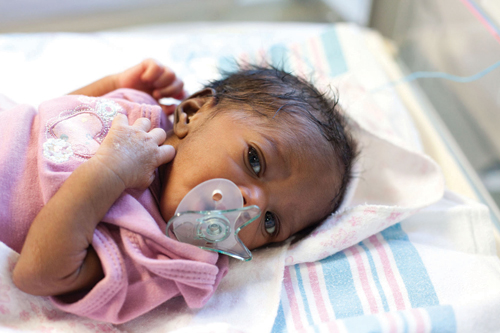By Joseph Giere, M.D.
In Haiti, pre-eclampsia and eclampsia result in a high number of high risk pregnancies and, sadly, a disturbingly high percentage of maternal and fetal deaths. For medical professionals who practice in Haiti, either as volunteers or full time, a general understanding of the clinical components is a life saving must.
For lay readers, what is important to understand is that so many of the factors leading up to these diagnoses are preventable; by committing resources to address the underlying issues of poverty, education, and quality medical care. And, successful treatment hinges on supporting medical programs tailored to the needs of women living in poverty in low resource countries like Haiti.
At CRUDEM/Hôpital Sacré Coeur, we take the medical concerns and lives of women and children very, very seriously. We do not think it is morally or ethically conscionable to walk away from the tragic circumstances that routinely arise just because a person has been born in Northern Haiti instead of Chevy Chase, Maryland. Every woman’s life and every child’s life are inherently valuable and deserving of our care, no matter where on the globe, they call their birth place.
 The following clinical components break down diagnosis and standard treatment protocols for this particular example of high risk pregnancy. I have also included notes that refer back to Julienne’s story.
The following clinical components break down diagnosis and standard treatment protocols for this particular example of high risk pregnancy. I have also included notes that refer back to Julienne’s story.
Definitions – High Blood Pressure (HBP)
There are two types of HBP: chronic HBP and PIH
Chronic HBP: Two BP readings of 140/90 or above recorded by readings earlier than 20 weeks of pregnancy
PIH (Pregnancy induced Hypertension): 2 BP readings recorded 4 hours apart noted either after 20 weeks pregnancy, during labor or 48 hours post partum.
There is a 50% risk that both chronic HBP and PIH will lead to pre-eclampsia which is defined by elevated BP and protein in urine.
Julienne came to her first visit late in her pregnancy. Did her high pressure occur before?
She was probably over 20 weeks and on her way to mild pre-eclamsia already.
HBP in pregnancy (PIH) can be considered:
Mild Pre-Eclampsia
(BP 140/90—150/110 and proteinuria)
Care for Mild Pre-Eclampsia: 140/90- 150/110 proteinuria when first diagnosed in pregnancy
Julienne had mild pre-eclampsia. Had she had general healthcare education about pregnancy and the resources to come to the hospital sooner, a sonogram taken much earlier than she received could have helped clear up some of the confusion and better approximated when she was due and the state of her baby. The discovery of twins in a first pregnancy only compounded her risks.
No clearly proven medical RX except observation and possibly bed rest upon first diagnosis. Early detection and your recognition of risks is the key.
Be Aware That:
The third trimester is time of increased risks and progression without warning. Therefore, the routine guidelines for visits at 32, 34, 36, 38, and 39 weeks for routine normal care are MANDATORY and the minimum required.
Unfortunately, this ideal early treatment scheme never really happened with Julienne. Her first pre-natal visit occurred far into her pregnancy. Again, Julienne, like so many rural Haitian women, lacked basic healthcare education. The distance from the medical center and the infrequency and costs of transportation were major deterrents to her making routine pre-natal visits.
Any potential risks of PIH for your patient (primigravida, previous eclampsia chronic HBP, Multiparity, obesity twin gestation) need to be recognized and to be highlighted on the record at first visit.
FIRST OBSTETRIC VISIT
• Identify risks for each individual patient.
• Discuss risks with this patient and your plan of care (consider a group class teaching/discussion).
• Have patient and companion repeat back to you their understanding of your plans for care and their role.
• Schedule more frequent clinic visits. The recommended schedule for normal third trimester visits at 32, 34, 36, 38, 39 weeks required for routine normal care need to be then individualized for any of the high risks you identify.
• Label patient chart as high risk. Specify the risk and date observed.
• Prepare a separate HI RISK OBSTETRIC journal listing each clinic hi risk patient for use by the inpatient Obstetric delivery staff to be available 24/7 at inpatient nursing station
• Julienne’s first visit was late. Time was lost. Fortunately, HSC can provide on the spot sonograms.
The lack of this critical equipment in many third world clinics might explain why many low resource countries fall behind first world countries where serious complications are more rapidly identified, seen less often and therefore produce better outcomes. While HSC is fortunate to have a sonogram and a technician to take the exam, the hospital would certainly benefit from donations to fund additional trained technicians.
During antepartum visits LOOK FOR and record signs of:
• Proteinuria: Check protein with dip stix (if none available protein can also be evaluated by filling 1/2 test tube with mid stream urine, add a drop of 2% acetic acid-vinegar, boil and estimate amount of white precipitate of protein left in tube.) Increasing amounts of urine protein is a dangerous sign.
A Dip Stix costs a few pennies in the US and are critical to proper care. If blood vessels are closing off and kidney leak protein is evident, the earliest damage is detected and the chances for positive treatment outcomes increase. Ensuring that clinics in low resource countries have ample supplies of Dip Stix is an inexpensive donation that can yield priceless results.
• Edema: Weight gain (can indicate fluid retention) DO NOT use diuretics (can lower placental blood flow volume to the fetus to dangerous levels)
Water not properly excreted by kidneys seeps into tissues. The brain can swell. The amount of liquid blood volume to nourish the placenta and the mother’s organs falls and placenta and organ failure occurs.
• IUGR: Careful frequent fundal height measurement. This may be the only sign available to you of fetal growth failure. (Nevertheless, serial sonograms, if available and done expertly, are ideal for monitoring growth and placental picture).
One of Julienne’s twins had a smaller head growth. Follow up head sonogram measurements of changes and growth is critical for optimum care. A sonogram can show signs of a failing placenta.
• Symptoms of headaches, stomach pains, nausea, eye sight blurring hyperreflexia – Record these changes and consider the symptoms and the progression of these changes. Rapid changes in severity are reason for frequent consultation and possible emergency action with hospital care.
Julienne only provided two opportunities to observe changes and by then it was getting too late to try simpler things, which was the reason she was hospitalized.
Treatment guidelines:
Even with mild eclampsia consider induction whenever possible because mild symptoms can be misleading and worsen rapidly. Induce and deliver when you judge
• Cervix easily induced
• Close to term
• Special nursery and nursing care available in birth facility
HSC was available and offered the full range of medical services and trained medical professionals to successfully deal with Julienne’s condition. Steroids for lung maturity were prescribed in hospital. It is doubtful that Julienne’s pregnancy would have gotten this far had she relied on the care of an unskilled birth attendant like the majority of Haitian women do.
TREATMENT AS INPATIENT FOR SEVERE PRE-ECLAMPSIA
Careful watchful waiting during antepartum period in the clinic. As you wait to allow fetus to mature because BP may be stable and because delivery is not an option, if you start to see a progressive development of and then worsening of mild symptoms with BP progressing higher to 150-160 systolic and 100-110 diastolic range (diastolic is more reliable than the more volatile systolic and a better sign of problems) then the original Mild pre-eclamsia state you are treating is clearly progressing. In effect the problem has now become more than mild pre-eclampsia. Start the use of outpatient medication, but use this only with careful frequent visits, and with clear patient understanding, patient cooperation and ability of patient to respond to plan of care.
Julienne really needed the safety of HSC observation. There was too much progression and the need for better observation. Julienne was one of the few, fortunate women in Haiti would had this option.
ARE FOR PIH PROGRESSING FROM MILD to Moderate STAGES INTO SEVERE PRE-ECLAMPSIA
Treatment advice for under 37 weeks (fetal viability) and with symptoms with Moderate stages of signs and symptoms:
In HSC, Julienne’s condition did not stabilize with medication but she did gain some time in maturing her twins while her own status worsened.
Start oral Medication as an outpatient:
Methyldopa Oral 250 mg q 8 H
250 mg q 8 h not to exceed 3 grams daily and DO NOT attempt to lower BP below 140/90 (Remember, adequate maintenance of placental blood perfusion is critical to avoid fetal compromise or growth restriction.)
Remember, this is a fine line and twins need even more than singletons and one twin already appeared behind in growth.
If treatment results in stable BP results and shifts to closer to “normal” range (140/90), then frequent 2x weekly checks are mandatory. Monitor the patient until 37 weeks. Remember DO NOT use diuretics or allow major BP fall to compromise fetal placental blood flow. THE IDEAL strategy to time delivery is to follow sonogram growth done by an experienced sonographer.
Toxemia is common in Haiti and Julienne’s experience teaches to respect pre-eclampsia. The only cure is delivery. Julienne’s conditions were no longer responding well to the prescribed therapy. She was in danger. Delivery was mandated. Fortunately, Julienne could benefit from skilled MDs and nursing staff and the onsite presence of an equipped NICU with trained attendants ensured a successful outcome.
If outpatient care is unsuccessful (BP CANNOT BE Lowered to 90-100 diastolic; there is progression to severe pre-eclampsia (150/110) or eclampsia occurs):
In severe pre-eclampsia, delivery within 24 hours should occur
Julienne was a severe Pre-eclamptic possibility ready to convulse.
In the case of eclampsia, delivery within 12 hours should occur
TREATMENT AS INPATIENT FOR SEVERE PRECLAMPSIA FOR LOWERING BLOOD PRESSURE
Treatment can include:
1. Hydralazine: Give 5mg IV SLOWLY Q 5 minutes until BP lowered repeat hourly OR give hydralazine 12.5 mg IM q 2 h as needed OR
• Hydralazine IV 5 ampules in 500 ml NACL0.9 or in Ringer’s lactate start at 15 drops /minute increase about every 5 minutes to max of 30 drops Once BP is controlled may decrease by 15-10-5 drops till BP is stable.
2. Labetololl: bolus 5 mgm slowly over 3-5 minutes double the amount each ten minutes up to the desired B P of 150/100 but DO NOT surpass 300mg dosage
Oral Labetolol is started 100mg b.i.d. and can be increased in additions of 100mg with need not to exceed 2.4 grams . . . Julienne had various combinations without real success.
BUT MgSO4 Sulfate is the recognized choice for preventing and treating convulsions in severe pre-eclampsia and eclampsia
TREATMENT AS INPATIENT FOR ECLAMPSIA (WHEN ECLAMPSIA OCCURS OR IN ANTICIPATION)
• Bed rails up
• Have IV with large needle in place
• Place Oxygen (4-6L/min), Ambu bag and masks, airway suction at bedside
• Tape padded tongue blade to wall for tongue protection
• Time clot formation in a tube of 2 ml venous blood – the absence of a clot or poor clot formation after 7 minutes is warning of bleeding problems
• Prepare a flow sheet at bedside to monitor time, fluids, urine output, medications, vital signs
• Calcium gluconate 1 Gm (10 ml 10% solution) given slowly to reverse for MgsO4 toxicity
Dosage schedule for Magnesium Sulfate for severe pre-eclampsia and eclampsia:
LOADING First dose 4 grams 20% IV slowly over 5 minutes
FOLLOW 10 gm 50% in each buttock deep IM with 1 ml 2% lignocaine (lidocaine) in syringe
MAINTENANCE dose 5 GM 50% MgSO4 deep IM alternate buttocks Q 4 hours
Do Not Use Dose if:
• Respirations fall below 16/minute
• There is less than 30 c.c. urine an hour
• Kneecap reflexes are absent
Delivery should occur once condition is stabilized (transfer to a birth center should have occurred with severe pre-eclampsia diagnosis.) Membrane rupture and or pitocin induction with anti convulsive therapy if possible, otherwise Cesarean Section with attention to clot formation, urine output and continuance of therapy for convulsions to last 24 hours after last convulsions or return to normal BP is necessary.
Cesarean section was chosen. The time was right. The twin babies were fragile, a long labor could be too chancy.
Toxemia of Pregnancy is a Disease Covering All Worlds
Toxemia of pregnancy is now rarely seen in the advanced state of convulsive eclampsia in the first world because it has been recognized and been treated earlier. Through the past centuries it has been one of a major hazard for women. Willian Byrd lies peacefully in a rural Virginia churchyard with the five tombs of his wives clustered around him. When English actress Jessica Brown Stanley left the popular TV series Downtown Abbey, it was easy to write her out of the story. Her character Lady Sybil Crawley developed toxemia and died in the grandeur of her father’s ancestral hall attended by an imported London specialist. Although even in her post world war time, once the condition was recognized the treatment was clear: immediate delivery by cesarean section. C Section in a pre-antibiotic era, without blood banking or sophisticated anesthesia, caused pause before the decision to perform surgery was made.
In truth, the cure was more known than the cause and this is still the case. Nutrition, a blood toxin (hence the name), possible genetic contribution from the father are among the hundreds of theories. I am told that in the courtyard of the University of Chicago, there are stone shields with the names honoring some of the discoverers of scientific medicine. The one reserved for the he or she who provides an explanation for the cause of Toxemia of Pregnancy remains a pristine stone.









